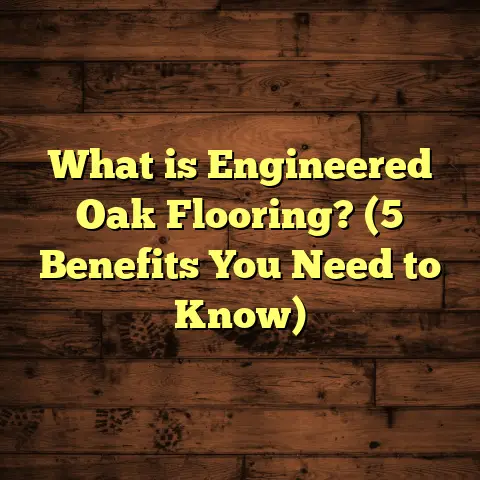What is LVT in Flooring? (5 Reasons to Choose Luxury Vinyl)
I want to talk about something that has become a staple in my flooring projects over the years—Luxury Vinyl Tile, or LVT. When I first started in flooring, I mostly worked with hardwood and ceramic. But as more clients began asking about alternatives that looked great but were easier to manage, I started exploring LVT. Now, it’s one of my go-to recommendations, and I want to share exactly why that is.
What is LVT in Flooring?
Let’s start at the beginning. You might hear the term “LVT” thrown around a lot, but what is it really? Luxury Vinyl Tile is a type of resilient flooring made from several layers of vinyl, engineered specifically to mimic the look and feel of natural materials like hardwood, stone, or ceramic tile. It’s not just a vinyl sheet cut into tiles—LVT has a layered construction that gives it durability, texture, and a realistic appearance.
Here’s how it breaks down:
- Backing Layer: This is the bottom layer that provides stability and support.
- Core Layer: Usually rigid or semi-rigid, it adds strength and helps the plank or tile maintain its shape.
- Design Layer: This is where all the magic happens. A high-resolution photographic layer gives LVT its realistic look, whether it’s wood grain, stone patterns, or ceramic tile designs.
- Wear Layer: The topmost transparent layer protects the floor from scratches, dents, stains, and fading.
The combination of these layers means you get a floor that looks like authentic wood or stone but comes with benefits vinyl offers—like water resistance and ease of maintenance.
I’ve found that this multi-layer design is a huge reason why so many people are choosing LVT for their homes and businesses—it balances beauty with toughness.
1. Durability That Holds Up Over Time
One of the first things I check when selecting flooring is how well it handles wear and tear. You might wonder: “Can a vinyl product really stand up to the daily grind?” In my experience, yes—and very well.
LVT can take a beating. The wear layer on many quality LVT products can be as thick as 20 mil (thousandths of an inch). For context:
- A 12 mil wear layer is good for residential spaces.
- 20 mil or thicker is suitable for commercial use or very high-traffic areas.
This thickness translates into floors that resist scratches from pet claws, dents from dropped objects, and stains from spills. One of my clients has three young children and a dog that loves running around indoors. We installed LVT in their living room and kitchen, and after two years of non-stop activity, the floors still look practically brand new.
In fact, according to data from the Resilient Floor Covering Institute (RFCI), high-quality LVT products can last anywhere from 10 to 20 years with proper care. That’s comparable to hardwood floors in many cases but without some of the vulnerabilities.
2. Water Resistance – A Game-Changer
Water damage is something that gives me headaches when dealing with hardwood or laminate flooring. I’ve seen cases where a simple spill or moisture buildup caused warping or swelling that required expensive repairs or full replacement.
LVT changes that narrative because it’s inherently water-resistant. Some brands even offer fully waterproof options. This feature makes it a perfect choice for rooms where moisture is unavoidable:
- Bathrooms
- Kitchens
- Basements
- Laundry rooms
I remember a basement remodeling project where the homeowners were nervous about moisture issues because their previous flooring had warped badly after a flood. We installed a waterproof LVT product designed specifically for basements. After more than a year of use and occasional water exposure, there were zero issues with swelling or damage.
Additionally, water resistance reduces the need for special sealants or coatings, which can increase installation cost and complexity with other flooring materials.
3. Realistic Looks That Impress
One thing that surprised me when I started working with LVT was how realistic it looks. I mean really realistic—so much so that sometimes even professionals have to take a second look.
Thanks to advances in printing technology and embossing techniques, LVT isn’t just a flat picture stuck on vinyl anymore. The design layer often comes with embossed textures that match the look of grain in wood or roughness in stone.
I’ve had clients who wanted hardwood floors but couldn’t afford traditional solid wood or didn’t want the upkeep. We chose LVT planks that replicated the color and grain of oak perfectly. When friends came over, they asked if we’d installed new wood floors because they couldn’t tell the difference at a glance.
Here’s what makes LVT stand out visually:
- High-resolution printed images provide authentic colors and patterns.
- Embossed texture adds depth matching real wood grain or stone veins.
- Wide variety of styles means you can find anything from rustic barnwood looks to sleek modern tile finishes.
From my experience, this combination lets homeowners get creative without sacrificing style for practicality.
4. Easy Installation Saves Time and Money
Installation can make or break any flooring project in my book. Hardwood floors require careful nailing or gluing; tile needs mortar and grout plus drying time; carpet demands padding and stretching.
LVT offers some of the simplest installation methods I’ve seen:
- Click-Lock Systems: Many LVT products come as planks or tiles that snap together without glue or nails.
- Glue-Down Options: For commercial settings or specific designs.
- Peel-and-Stick: For smaller DIY projects.
This versatility speeds up installation and lowers labor costs significantly. A couple of years ago, I installed over 800 square feet of click-lock LVT in a family’s entire downstairs area in just two days. The homeowners appreciated how quickly we finished without sacrificing quality.
For people who want to try installing themselves, peel-and-stick options are fantastic—though they work best on smooth, clean subfloors.
5. Comfort and Sound Absorption
If you’ve ever stood on tile or stone for a long time, you know how uncomfortable it can get. LVT provides some cushioning thanks to its layered construction.
The softer surface means less strain on your feet and joints when you’re cooking in the kitchen or hanging out in your living room all day. I installed LVT in an office space recently where employees had complained about noisy footsteps on hard floors. After switching to LVT with an added underlayment, sound levels dropped noticeably.
This sound absorption makes rooms feel cozier and reduces noise echo—a detail many people overlook until they experience it firsthand.
My Personal Take: Why I Recommend LVT So Often
Over the years, I’ve tested many flooring types across different projects—luxury hardwood, engineered wood, laminate, ceramic tile—you name it. While each has its place, LVT keeps impressing me for these reasons:
- It balances aesthetics with durability.
- It fits well in almost any room.
- It simplifies installation.
- It saves money long-term due to low maintenance.
- It offers comfort not usually found in resilient flooring types.
One story sticks out: A family I worked with wanted hardwood looks but had two active dogs who often tracked mud inside. Hardwood would have required constant refinishing or replacement. We chose LVT instead. Months later, they thanked me because they could clean up messes quickly without worrying about ruining their floors.
What About Cost? How I Use FloorTally for Budgeting
Cost is always on everyone’s mind when deciding on flooring. You want the best value without overspending or getting surprises during installation.
I rely on FloorTally—a tool that lets me input project details like room size, material choice (including various LVT brands), labor rates based on my location, and waste factors to estimate total costs accurately.
Why do I like FloorTally?
- It gives me a quick breakdown of materials versus labor costs.
- I can compare options side-by-side (like different wear layers or installation types).
- It helps plan budgets realistically before ordering materials or starting work.
- It accounts for extra material needed due to cutting waste.
Using this tool has saved me hours of manual calculations and guesswork and made communication with clients smoother because I provide clear cost expectations upfront.
Understanding Different Types of LVT Products
Not all Luxury Vinyl Tiles are created equal; there are variations depending on thickness, finish, and installation method:
Glue-Down LVT
These tiles require adhesive applied to the subfloor before laying down each piece. They tend to have a thinner profile but offer excellent durability and stability in commercial environments.
Click-Lock LVT
This type features interlocking edges that snap together without glue or nails. It’s more popular for residential use due to ease of installation and repair. If a plank gets damaged, you can replace just that section without pulling up the whole floor.
Loose Lay LVT
A newer option where tiles are designed to stay put due to weight and friction rather than adhesive or locking mechanisms. Great for renters or temporary installations.
Each type serves different needs depending on budget, room use, and skill level of installer.
How to Care for Your LVT Floor
Because vinyl is durable but not indestructible, some simple care steps will keep your floor looking great:
- Sweep regularly to remove dirt particles that could scratch the wear layer.
- Use damp mopping with manufacturer-approved cleaners—avoid harsh chemicals.
- Place felt pads under furniture legs to prevent gouging.
- Clean spills promptly to prevent staining.
- Avoid dragging heavy items across floors; lift instead.
I’ve seen clients keep floors pristine for years just by following these easy habits.
Common Questions About LVT Flooring I Hear
Q: Can I install LVT over existing flooring?
A: Often yes! Many types can be installed over vinyl sheets or tiles if the surface is smooth and stable. For wood or laminate subfloors, make sure they’re level without gaps.
Q: Will pets damage LVT?
A: Pet claws aren’t likely to scratch most quality wear layers on LVT. Plus, water resistance helps protect against accidents.
Q: Is LVT eco-friendly?
A: Vinyl production has environmental impacts but newer products increasingly use recycled materials and low-VOC adhesives for better indoor air quality.
Q: Can LVT be refinished like hardwood?
A: No. Once worn through the wear layer, replacement is necessary rather than refinishing.
My Final Thoughts on Choosing Luxury Vinyl Tile
If you want floors that combine style with practical benefits—durability, water resistance, comfort—LVT should definitely be on your list. Over my years installing flooring in homes and businesses alike, I’ve watched Luxury Vinyl Tile evolve from a budget option into a sophisticated choice capable of competing with pricey natural materials.
It saves time during installation and reduces stress about spills or scratches while offering design flexibility unmatched by many other options.
If you haven’t considered it before for your home or project, maybe now’s the perfect time to explore what it has to offer firsthand!
And remember: budgeting tools like FloorTally can make planning easier by breaking down costs clearly so you know exactly what you’re getting into.
Would you like me to help figure out if your space would benefit from LVT? Or maybe share some supplier recommendations based on your area? Just ask! Flooring choices don’t have to be complicated—I’m here whenever you need advice based on real-world experience.
This article aims to be both informative and relatable by sharing facts alongside practical insights from my work—and by keeping questions flowing so you feel part of the conversation as we explore what makes Luxury Vinyl Tile such a popular flooring option today.





